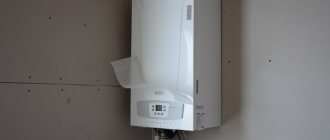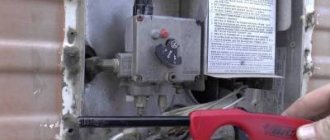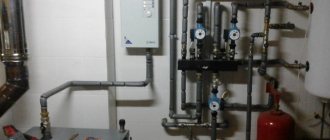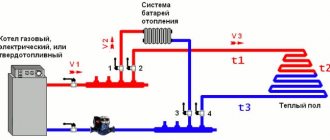Advantages and disadvantages of gas fireplaces
Gas-powered heaters have a number of advantages:
- Compared to a brick portal, installing a gas analogue is much easier.
- There is no need to prepare firewood or store it, and the process of heating and maintenance is simplified.
- Minimum fuel cost, especially compared to the electric option.
- Natural fire, not imitation flame.
- Energy independence.
- The efficiency is higher than that of its wood-burning counterpart.
- Real benefit, can be used as an alternative way to heat your home.
- Some models are mobile and can be rearranged.
- High level of security, various automatic control systems and settings.
Minuses:
- A gas utility permit is required to install new equipment if it is connected to a gas pipeline. In the case of propane/butane, you need a permit under which you can purchase new cylinders. It's much easier to get.
- Relatively high cost. “Relatively”, because brick solid fuel analogues can cost the same, or even more. And their electric counterparts are more wasteful in further use.
- If you plan to work with propane/butane, you will need to regularly order and change cylinders.
- Combustion products, although in small quantities, are still present. If you use the device in a closed, unventilated area, an unpleasant odor may occur.
And of course, the fireplace should not be left unattended and its operation should not be taken lightly, since we are talking about an explosive substance.
Gas fireplaces without chimney
The principle of operation of chimneyless fireplaces is the complete combustion of fuel, which leads to the absence of combustion products.
They are used as decorative elements and are manufactured in several modifications:
- Floor-standing fireplaces for a home on gas without a chimney look like a regular island fireplace.
A small gas cylinder is installed inside the case, the capacity of which is sufficient for full operation for several hours.
Floor-standing models are often equipped with wheels or can simply be moved to any convenient place. A convenient option because it does not require special tricks during installation and can be used even outdoors, verandas and cafes.
Hanging and built-in fireplaces. Easy to install outdoors, creating a cozy and comfortable atmosphere.
Installing stationary built-in devices is more difficult, but the result is more aesthetically pleasing. The front panel of the fireplace is flush with the wall, the device does not hide the space of the room. You can also “hide” gas supply lines in the wall. In addition, such a fireplace can be decorated with a wall, then the flame can be observed from two or even three sides.
The models are completely safe; no toxic combustion products are released during combustion. To install a chimneyless fireplace, there is no need to obtain permits. To ensure proper operation, the room should be ventilated before turning on the device.
Advantages of gas fireplaces without a chimney
When choosing, most buyers are guided by the ratio of positive and negative properties of heating equipment.
Comparing the pros and cons, they make a certain choice and make a purchase.
Gas fireplaces for apartments without a chimney have a number of distinctive features:
- Quick ignition.
While wood or charcoal takes a long time to ignite effectively, the gaseous mixture ignites immediately and within minutes you will feel the temperature in the room increase.
- Additional properties.
Many models are supplemented with devices that simplify the operation process. For example, a thermostat can control the level of heat generated to optimize fuel consumption.
- Simplified operation.
Installation requires a minimum of effort and time; you do not have to constantly move logs, chop wood and look for coal.
- Environmental Safety.
Gas-powered structures emit minimal pollutants into the atmosphere. An alternative option may be to use biogas obtained from waste processing - when burned, it emits significantly less carbon dioxide.
Criterias of choice
First of all, people pay attention to the type of fuel when they decide to purchase a comfortable fireplace for their home or apartment. This parameter is very important
Options for main gas are indicated by the sign “N”, and those designed to work with cylinders filled with propane-butane - “P”.
Then the purpose is determined. A fireplace may be needed to heat a room or simply as a decorative element. All gas fires usually combine both functions, but for heating you need to choose the appropriate power. It is not so important if the fireplace will simply decorate the interior - here they are more focused on fuel consumption and the appearance of the device.
Thermal power is measured in kW and calculated by the volume or area of the room. Manufacturers always indicate the maximum area, but you need to understand that this calculation was created for an initially insulated room. Typically, one kW of power is required per ten square meters.
When purchasing fireplaces powered by a cylinder, the gas consumption parameter will be important. At the time of purchase, you need to study this data in the characteristics of the model. Consumption is usually indicated at maximum heating mode, but if the fireplace burns more often in decorative mode, then this parameter will be significantly lower.
Fireplaces differ in the type of installation. Floor-standing models are popular - they are simply installed on a base, then connected to the chimney. Wall-mounted ones are fixed to the wall using brackets. Such options are preferable if there are children and pets at home. For built-in models, you will need a ready-made portal made of non-combustible materials and a chimney. Open fireboxes can be installed in a recreation area, since they do not require a chimney.
Shape and material
The shape of the firebox is important if you want to place it harmoniously in a certain interior. It can be very diverse:
- frontal for placement against walls;
- corner;
- island for the center of the room with a good view;
- double-sided through for installation in interzone partitions.
Of course, the choice of shape depends on the taste of the buyer, but it is important to take into account the connection of the chimney with gas lines. In a country house, the chimney can be routed through walls and ceilings, so the type of installation is not so important here
But in the case of an apartment, it is better to choose corner or front options, which are placed close to the external wall of the building. The gas supply pipe must not be laid hidden in the walls. There must be clear access so that the pipe can always be inspected.
When gas burns, water vapor, sulfur compounds, and carbon dioxide will be formed. If the fireplace is made of ordinary steel, the material will quickly collapse under such conditions. Cast iron options are the most reliable. But they always have a higher price, and besides, they weigh a lot. Stainless acid-resistant steel is most preferred. It has a long service life and a high price.
Additional functions
Almost all models are now produced with the functions necessary for convenient operation - electric ignition, gas control, rollover control, automatic adjustment of combustion modes. The presence of these options will also affect the cost of the fireplace insert. If your budget is modest, then it is better to choose only the most necessary functions that will ensure safe use. After all, users don’t even use most of the options or do so extremely rarely.
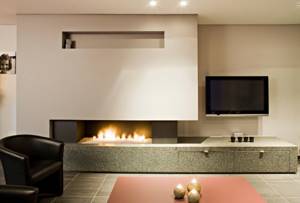
Such a fireplace can have a lot of functions
For many buyers, an important factor is the remote control for the purchased device. They now go to many modern models. With their help, you can easily change various available functions, turn the device on or off, without going near it.
What should you consider when choosing a fireplace?
Before choosing a gas fireplace insert for installation in an apartment or house, you need to clarify the characteristics you need, which will allow you to make the best choice.
Type of fuel
The fuel for gas fireplaces can be main gas or bottled gas. This parameter is extremely important, since fireboxes designed for one type of gas are not suitable for another, and their use is not safe. Models for working on main natural gas are marked “N”, for working with a cylinder filled with propane-butane - letter “P”.
Purpose of the fireplace
You can install a fireplace to heat your home or apartment, or simply to decorate and create coziness. All gas fireboxes combine these functions, but gas fireplaces for heating a house or cottage must have sufficient heating power. A fireplace intended only for interior decoration can be selected without taking this parameter into account, focusing on its design and fuel consumption.
Thermal power
A parameter important for a stove or heating fireplace. It is measured in kW and calculated by the area or volume of the room. Typically, the manufacturer indicates the maximum area that a particular model can heat, but it should be taken into account that the calculation was made for a well-insulated building.
On average, for every 10 square meters, 1 kW of thermal power is needed, but if the fireplace is used as an additional source of heating or only in the summer in the country, half of this value is enough.
type of instalation
Gas fireplaces also differ in the type of installation and installation. The most popular:
- floor-mounted, which simply need to be installed on a prepared base and connected to the chimney;
- wall-mounted - they are fixed to the wall using brackets, such models are safe and convenient for homes where there are small children and animals that can get burned;
- built-in - for their installation you need a ready-made or home-made portal made of non-combustible materials, as well as a chimney;
- open , outdoor fireboxes are an excellent option for installation in a gazebo or on a recreation area; they do not require the installation of a chimney.
Built-in models are the most realistic, but their installation is complicated and requires construction skills or calling in specialists. Floor and wall models are easy to install, and the services of a specialist will only be required for installing the chimney and main gas pipeline. An outdoor fireplace running on bottled gas can be installed with your own hands without the approval of supervisory services.
The connection to the main gas must be carried out by a representative of the gas service serving your area. Unauthorized connection is dangerous and can lead to a fire, as well as result in a fine from supervisory authorities!
Video: facing a corner fireplace
Firebox shape
A characteristic important for placing a fireplace in the interior is the shape of the firebox. It can be different:
- frontal for installation against a wall;
- corner, it is placed in the corner;
- island fireplaces are installed in the center of the room, they have visibility from all sides;
- a double-sided through firebox is visible from both sides; such fireplaces are usually installed in partitions that zone the room.
The choice of fireplace shape depends mainly on your taste, however, it is necessary to take into account the gas line and chimney. In a private house, the chimney can be brought out either through the wall or through the ceiling, so a fireplace with any type of installation is suitable for a country house. For an apartment, they usually choose front or corner models with placement close to the outer wall of the building, through which the chimney can be brought out without any problems.
The main gas supply pipe must not be laid hidden in the wall or ceiling! Access to it must be open for inspection and control!
Video: installing a built-in fireplace
Body and firebox material
When gas burns, water vapor, carbon dioxide and sulfur compounds are formed, therefore condensation with an acidic pH factor is formed in the firebox and chimney. A firebox made of ordinary steel quickly corrodes and collapses under such conditions.
Cast iron fireboxes are considered more reliable, due to the high content of graphite in the crystal lattice of cast iron; this material is more resistant to aggressive condensate. At the same time, cast iron fireboxes are much heavier and their price is higher.
The most reliable option is a firebox made of stainless acid-resistant steel , which can operate for a long time in conditions of condensation deposition. Their service life is longer than that of other models, but the price is higher.
Gas consumption
The parameter is most important for fireplaces operating on liquefied gas marked “P”. If gas consumption is high, the cylinder will quickly become empty and will require replacement or recharging, which will result in extra time and money.
To avoid this, it is necessary to clarify the gas consumption when purchasing - it is usually indicated in the main characteristics of the model. It should be taken into account: the consumption is indicated in the maximum heating mode; when burning in the decorative mode, it is significantly lower and amounts to 15-40% of the nominal one.
Automation and additional functions
Almost all modern models of gas fireplaces are equipped with functions that ensure not only safety, but also ease of use of the firebox. The most necessary and popular options:
- electric ignition, eliminating the introduction of open fire into the firebox when starting the fireplace;
- flame detection system and gas control - when the fireplace goes out or gas supply stops, its further supply is blocked until the firebox is restarted;
- rollover control, relevant for floor- and wall-mounted models; when the position of the firebox changes, the gas supply stops;
- automatic regulation of combustion modes according to specified parameters;
- control using remote control;
- the ability to connect remote climate sensors - they are installed in the room, and when the air temperature changes, the fireplace automation itself regulates the combustion power.
The presence of these options affects the price of the fireplace insert, so if you have a modest budget, it is better to choose only the most necessary ones that ensure safety.
Gas fireplace for a summer house
Gas fireplaces for summer cottages have a high efficiency of up to 85% and a power of up to 15 kW, which means that fuel is not wasted, but high-quality heating of the room is produced. With this power you can heat a house of 150 square meters; for small buildings you can choose a fireplace with a power of up to 6 kW.
The fuel is environmentally friendly; after combustion, steam and carbon dioxide are released into the open air, since the decorative elements are not flammable and do not emit toxic substances.
A gas fireplace consists of a steel or cast iron firebox; it can be open or closed; in the first case, the structure is installed away from objects that could catch fire. In the second case, the firebox is covered with special fire-resistant glass. Inside there is a burner from which fire is supplied to decorative elements, artificial coals or firewood. The ignition device is located in the same part. There is a control panel on the outside; you can also change the operating modes of the fireplace using the remote control. The gas fireplace has automatic control that regulates combustion, special sensors that stop the gas supply in case of malfunction, and a thermostat that maintains the temperature in the room. The latter device can also be purchased separately.
Gas burners can be simple, or with infrared radiation, with decorative elements on top.
Gas fireplaces can be placed in the country house without creating a chimney in the classic form. In order to remove combustion products, you can use a ventilation pipe made of steel; it has a heat-insulating intermediate part that prevents the accumulation of condensate.
Outdoor fireplaces are placed in gazebos or on open verandas; they do not require a chimney, since combustion products are released into the air.
The most interesting models
Consider gas fireplaces for an apartment or private house. The review will present models from various price categories. For apartment installations, it is necessary to consider the installation of the chimney.
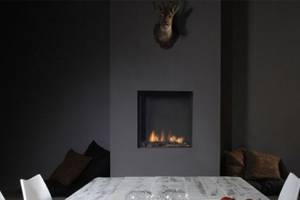
Gas fireplace Faber Fyn 450
We have before us an extremely compact fireplace that runs on gas fuel. It is designed to be built into a wall; combustion products are discharged through a coaxial chimney with a diameter of 100 mm. A power of 3.2 kW will ensure the supply of a significant amount of heat to residential premises. The depth of the unit is only 283 mm, it will fit into a small niche - most likely, you will have to add a false chimney, since the walls in the apartments are quite thin. A remote control is included in the kit. The estimated cost of the model is 155-160 thousand rubles.
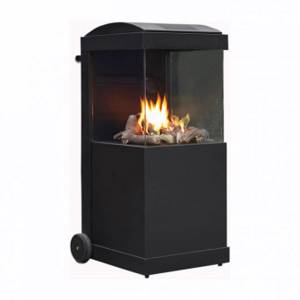
Floor-standing fireplace Faber The BUZZ
A typical gas fireplace for a summer house, from where it can be removed if necessary.
For this purpose, it is made in a transportable form factor. When you first look at it, associations arise with a mobile apparatus for producing popcorn in outdoor conditions - the same massive base and a firebox open on three sides (closed with glass). Inside the fireplace we see an imitation of wood-burning masonry, it is necessary to achieve maximum similarity with wood-burning fireplaces. The power of the unit is 9.3 kW, power is supplied from a cylinder. The intensity of the flame is adjusted at the discretion of the users. An undoubted advantage will be the presence of a “clean glass” system - the device is not afraid of soot. The total weight of the stove is about 51 kg, the cost is 124 thousand rubles.
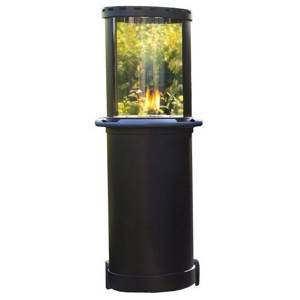
Floor-standing fireplace Faber Tube
Well finished country house gas fireplaces should be beautiful and attractive. That is why we included this model in our review. It is made in a slender vertical body with a height of 144.8 cm. Thermal power is 6.5 kW, and a flame level adjustment function is provided. A special feature of the model is its small thickness - when installed against a wall, it will not take up much space and will not clutter up the space. The approximate cost is 185 thousand rubles.
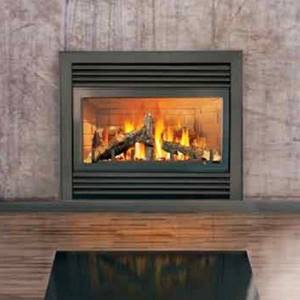
Napoleon GD 33
A high-quality gas fireplace using bottled gas with a shallow body depth - only 330 mm. The height is 750 mm - the firebox is quite large. The location is wall-mounted; it is possible to complement the model with any type of portal, including a brick one. Food comes from a liquefied gas cylinder; there is a fuel supply control system on board. Special attention should be paid to the firebox:
- Impressive dimensions - in front of us is a full-fledged fireplace, pleasing with a wide flame.
- Realistic wood stacking – your guests will have the feeling that natural wood is burning in the firebox.
- Ease of installation in apartments and private households - modifications are available with a top or rear exit under the chimney.
The approximate price is about 175 thousand rubles.
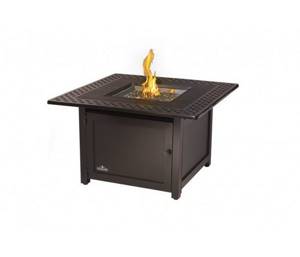
Napoleon Victorian 1061
A fireplace can be installed not only in the home, but also outside it - for example, in the backyard, on a recreation area, patio or terrace. We invite you to familiarize yourself with the model for outdoor installation. If desired, you can place a hood above it, mounting the fireplace right in the middle of the room. The body is made of steel and cast aluminum, and contains an 11.7 kW burner made of stainless steel.
A small gas cylinder is hidden inside the base. Model features:
- Built-in protection against gas leakage in case of flame extinguishment.
- Complete glass screen for wind protection.
- Dimensions – 107x107x63.5 cm.
The cost of a gas fireplace is about 90 thousand rubles.
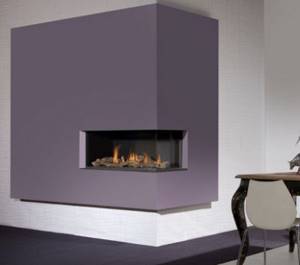
Faber Duet PR L
Here we have a rather interesting built-in gas fireplace with a closed firebox.
It is connected to a coaxial chimney, which is discharged beyond the nearest wall to the street. The heat output is 7.1 kW, the gas is ignited using an electronic igniter. The combustion intensity can be adjusted using a remote control. The firebox is made of corrosion-resistant stainless steel. This fireplace is equipped with a gas burner with support for several combustion modes - with uniform flame distribution, with fire concentration in the central part, with adjustment of combustion intensity. The firebox itself is decorated with imitation firewood or Carrara pebbles - these are non-combustible materials, so the safety of the product does not suffer. The width of the model is 1074 mm, height – 738 mm, depth – 474 mm. Operation from natural or liquefied gas is possible.
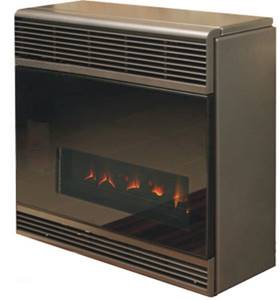
Karma Beta 2
The most affordable model in our review, it can be bought very inexpensively - for only 42 thousand rubles.
We assure you that this is a completely reasonable price; the vast majority of gas fireplaces cost significantly more. The device is made in a compact case - dimensions are 416x600x215 mm and weighs 15 kg. Installation is carried out on the wall, propane or butane is used as power. The efficiency is 94%, thermal power is 2 kW. The body is made of metal, the front part of the firebox is covered with glass. A gas fireplace is connected to a coaxial chimney, taking combustion air from outside. The flame is low, the viewing window is very small. We can say that this device is designed more for heating rooms than for performing decorative functions - it does not shine with an interesting appearance, more reminiscent in its design of an oversized convector.
Gas fireplaces (Gas)
- Country Hungary
- Type Gas
- Installation type Floor standing
- Weight, kg 34
- Country Czech Republic
- Type Gas
- Installation type Wall
- Weight, kg 15
- Country Netherlands
- Type Gas
- Installation type Floor standing
- Firebox material Steel
- Country Netherlands
- Type Gas
- Installation type Built-in
- Firebox material Steel
- Country Czech Republic
- Type Gas
- Installation type Wall
- Weight, kg 23
- Country Netherlands
- Type Gas
- Installation type Floor standing
- Firebox material Steel
- Country Netherlands
- Type Gas
- Installation type Built-in
- Firebox material Steel
- Country Netherlands
- Type Gas
- Installation type Floor standing
- Firebox material Steel
- Country Netherlands
- Type Gas
- Installation type Wall/Floor
- Firebox material Steel
- Country Netherlands
- Type Gas
- Installation type Floor standing
- Firebox material Steel
- Country Czech Republic
- Type Gas
- Installation type Wall
- Weight, kg 19
- Country Czech Republic
- Type Gas
- Installation type Wall
- Weight, kg 23
- Country Czech Republic
- Type Gas
- Installation type Wall
- Weight, kg 19
- Country Czech Republic
- Type Gas
- Installation type Wall
- Weight, kg 23
- Country Czech Republic
- Type Gas
- Installation type Wall
- Weight, kg 15
- Country Czech Republic
- Type Gas
- Installation type Wall
- Weight, kg 15
- Country Hungary
- Type Gas
- Installation type Floor standing
- Weight, kg 30
- Country Hungary
- Type Gas
- Installation type Floor standing
- Weight, kg 34
- Country Czech Republic
- Type Gas
- Installation type Wall
- Weight, kg 19
- Country Czech Republic
- Type Gas
- Installation type Wall
- Weight, kg 15
Gas fireplaces: what are the advantages?
The heating function of modern fireplaces has long faded into the background, bringing forward the aesthetic component. Today people buy fireplaces not to keep warm, but primarily to decorate their home, creating a corner of comfort and coziness in it. There are few interior items that can compare with a fireplace in terms of their impact on the environment and the ability to transform it for the better.
A wood-burning fireplace can be considered a “classic of the genre,” but, unfortunately, not all buyers have the opportunity to install it. In an urban environment, one of the most affordable types of fuel is natural gas, so a gas fireplace will be an excellent alternative to a wood fireplace, almost in no way inferior to it in beauty and sophistication, or in functionality. It is easier to install and simpler, safer and more economical to operate. Thanks to the use of special decorative substitutes for burning firewood, even upon closer inspection, the “picture” created by the fireplace will correspond to what we are used to seeing in the firebox of a classic fireplace - cozy crackling wood and living flames of fire.
Advantages of gas fireplaces:
- high aesthetic properties - burning fuel creates a natural fire, and high-quality ceramic copies are used to imitate firewood;
- ease of installation;
- lighter weight compared to classic wood-burning analogues;
- high heating efficiency;
- the best option in terms of price/quality ratio, including due to the efficiency of the fuel used;
- Fire safety;
- ease of operation, no need to constantly clean the fireplace from combustion products.
In general, a gas fireplace is a more affordable option for installation, while it perfectly performs its main function today - aesthetic, creating the required atmosphere of warmth and comfort. Having installed it in your house or country house, you will immediately feel how everyone in the household will be drawn to this room, how pleasant it will be to sit together by the fireplace on long evenings with the whole family and enjoy warm, sincere communication.
Gas fireplace: a new generation hearth
Gas fireplaces are an excellent alternative to wood heating appliances. Owners of such fireplaces can easily enjoy the play of live fire, using the most economical type of fuel - methane or liquefied propane-butane. In terms of its aesthetic characteristics, a gas fireplace, as many believe, is in no way inferior to a wood-burning fireplace, and in some operational parameters it sometimes surpasses it.
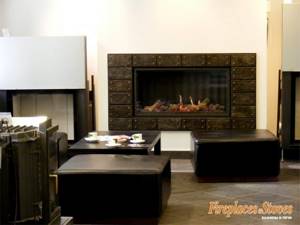
The range of gas fireplaces offered by the modern market is quite wide. Among the huge variety of models of various sizes, styles and colors, everyone can find a fireplace to suit their taste, for their interior. Fireboxes and linings for gas fireplaces have a very diverse design; their configuration can be any: rectangular, spherical, pyramidal, teardrop-shaped... By the way, unlike a solid fuel fireplace, a gas fireplace can also be mobile, which is very convenient when you need to quickly heat different rooms of the house . And this is just one of the advantages of gas fireplaces over wood fireplaces.
INSTEAD OF FIREWOOD
The fuel for gas fireplaces, as you might guess, is natural gas and liquefied propane-butane. Such a fireplace can be installed in any room where there is a gas supply, or simply connected to an autonomous gas cylinder. Fireplaces running on natural gas are marked “N” (“Natural”), and those running on liquefied propane-butane are marked “P” (“Propan”). By the way, you should keep in mind that a fireplace designed to operate on natural gas cannot be operated on liquefied gas, so you should decide on the type of fuel before purchasing the device. The decorative effect of burning logs and hot coals, for which a classic wood-burning fireplace is often built, is achieved in gas fireplaces through special fireproof accessories that imitate firewood, coals and even ash (which does not need to be constantly raked out - and this is another advantage). The living flame of a gas burner, enveloping such a dummy, creates the complete impression of a genuine wood-burning fireplace. The illusion of a living flame covered by a glass screen is so great that an inexperienced viewer may not be able to distinguish a built-in gas fireplace from a classic wood fireplace by its appearance.
LIVING FLAME FOR ONE OR TWO
And one more undeniable advantage: while lighting a wood-burning fireplace can be not so easy, turning on a gas fireplace is as easy as a gas stove. This is done literally with one click using a piezo lighter built into the gas supply system. The device that supports combustion in a gas fireplace is an atmospheric gas burner equipped with an automatic control system. The automatic control system maintains constant gas pressure in the burner. As a rule, gas fireplaces have a remote control, which makes their operation incredibly simple and convenient for those who do not want to get up from the couch. Many models of domestic and imported gas fireplaces are equipped with a thermostat that maintains the set temperature in the room. For a gas fireplace that does not have its own thermostat, you can connect an external room thermostat.
SECURITY AT THE LEVEL
Modern gas fireplaces are truly safe: they are necessarily equipped with tip-over sensors and a special air analyzer, which shuts off the flow of gas to the burner if the content of carbon monoxide in the air exceeds the permissible limit. Special devices, as we have already noted, maintain constant gas pressure in the burner, and also allow you to regulate fuel consumption in the fireplace and provide control over the continuous supply of gas to the burner; if the flame goes out, the gas supply automatically stops.
FOR A BIG HOUSE
The power of gas fireplaces is quite high - it reaches 10 kW, that is, a gas fireplace can heat a room with a volume of up to 200 m3. In order to correctly calculate the required size of the fireplace, you should seek the help of a professional who will make an accurate calculation of the heat loss of the house, taking into account the volume of the room to be heated, the presence and quality of insulation, the size of the windows, as well as other energy characteristics of the house.
INSTALLATION
In a city apartment, installing a liquefied gas fireplace will inevitably be accompanied by difficulties, sometimes significant ones. You will need mandatory permission from gas service specialists and, most likely, work to move gas pipes, since in most apartments gas is piped only to the kitchen. But no difficulties will stop real lovers of improving the interior of their home. When installing a gas fireplace in your home, you must follow certain rules, because this is serious heating equipment that can be dangerous if installed incorrectly. Without exception, all gas fireplaces (both mobile and stationary) must have an appropriate certificate and operating instructions with a list of technical requirements stipulating the specifics of connecting the unit to the gas main. Only gas specialists should lay the internal gas pipeline and install the fireplace. As a rule, most stores selling fireplaces have an equipment installation specialist on staff. Otherwise, you can always find a company that specializes in installing fireplaces (just remember to make sure that this company has the appropriate license to install this type of equipment). Installation of a gas heater usually includes, as we have already noted, work on laying a gas pipeline and moving gas pipes, a chimney and the fireplace itself, as well as laying electrical wiring for a fan and thermostat. The room where a gas fireplace is to be installed must be well ventilated. We should also not forget that the fireplace should be installed at some distance from other objects that could ignite from its flame. The minimum permissible distance to other objects is often indicated in the instructions for using the fireplace; if such data is not available, the installation specialist will be able to calculate this distance himself.
CHANGE WOOD-MOUNTED TO GAS
By the way, if you want to replace a wood-burning fireplace with a gas one, it will be useful for you to know that separate decorative burners are also produced that run on propane-butane, which are inserted into the niche of a regular wood-burning fireplace. The burner is placed quite deep in the combustion chamber, and all combustion products exit into the chimney. For those who are tired of lighting damp wood for hours and watching the flame, this is the most suitable option.
FINALLY
Modern gas fireplaces are a real godsend for those who do not want to waste time lighting logs and maintaining a flame in the firebox, extinguishing coals and cleaning the chimney. For those who value practicality and convenience, but do not want to give up the beauty of dancing flames. The atmosphere of a home is now turned on with one click of a piezo lighter. Technological, environmentally friendly, and economical, a gas fireplace can rightfully be called a new generation fireplace and is fully suitable for people seeking to combine coziness and maximum comfort in the interior of their home or apartment.
Expert commentary
Sergey Olegovich Klimatsky, director of GEFEST GROUP (St. Petersburg) I myself have been using a gas fireplace installed in a city apartment for several years. Gas fireplaces have a number of undeniable advantages: in addition to convenience and cleanliness, they do not require a chimney that goes to the roof - the pipe can be installed on the facade of the building without any damage, which allows the use of gas fireplaces on any floor of a multi-story building. The capacity of a small gas cylinder is enough for several months, and the remote control allows you to light a live fire in the fireplace with one click. Source: Fireplaces&Stoves magazine No. 3 (03)
Types of gas fireplaces by installation type

According to the installation method, there are wall-mounted models, free-standing, corner installation and double-sided designs. The wall ones are decorated with a portal, which is part of the fireplace complex. It can be purchased online or made at home. They are usually produced in the form of a U-shaped or D-shaped frame. External decoration is made according to the owner’s taste and should be combined with the surrounding interior decoration of the room.
The chimney is built into the wall or is installed externally. Installing a flue or coaxial pipe requires installing fireplaces in a strictly defined location. Corner structures fulfill their main task - to save space in a small room. They, like the wall ones, are enclosed in a portal, only of a corner design.
The ability to view fire from one device from 2 different rooms is implemented in a double-sided modification. Its unique feature is the glazed walls of the combustion chamber. Such options are mounted in the wall of the building, dividing the premises into zones. The width of such a wall corresponds to the size of the firebox, and therefore a similar fireplace design is chosen even before the construction of the house. In addition to the above-mentioned fireplace designs, there are options with open and closed fireboxes, as well as those operating on liquefied or main gas.
Types, advantages and disadvantages
All gas fireplaces can be grouped into two distinctive components: with an open firebox and with a closed firebox. It is not difficult to distinguish them by this feature.
- In open fireplaces, which can allow the flames to be viewed from all sides, the fire is open and directly heats the air.
- The second category of fireplaces uses protective glass to cover the flames and dummy wood inside the firebox. Island fireplaces, a type of open fireplace, are installed in the center of the room. This is where they get their name from.
If, after painful deliberation, you decide to equip yourself with a gas fireplace, then you can objectively evaluate its performance only after installation and a certain period of use.
Advantages:
- Gas has a high specific heat of combustion, which explains the level of efficiency, which is incomparably higher than that of a wood-burning fireplace. In our case, it can exceed 80%.
- Caring for a gas fireplace eliminates the need for daily control of soot and disposal of combustion products in the form of ash.
- Fuel dosing is fully regulated by an automatic system, both electronic and mechanical. This means that, regardless of the degree of modernity of the model, a gas fireplace in an apartment does not require constant adjustments and intervention during operation.
- Combustion products are removed through the chimney. In an apartment in a multi-storey building, you can use the built-in ventilation duct as a chimney. But there are often cases when residents install the hood themselves. A properly installed gas removal device is a guarantee of safety.
- In our minds, gas equipment is a metal casing, a set of supply pipes and a sad vegetation in the corner of the room. A fireplace changes all stereotypes, as it allows you to diversify the style of decoration, make it in a classic or modern version, decorate it with any finishing materials, and combine the decoration with the interior.
Simple modern interior
Flaws:
- Any installation work, from installation to relocation, must be carried out only by specialized organizations.
- The first start-up of the fireplace is accompanied by permits from the gas and fire departments. The owner, on his own initiative, cannot make any changes to the design or its operation.
- Fireplaces are equipped with a pipe that acts as a chimney. If it is located far from the built-in ventilation duct, then a lot of work needs to be done, which must be agreed upon with the fire inspector.
- Modern fireplaces are automated by electronic control systems, which means they require electricity. They are small, but installing a fireplace involves installing an outlet in close proximity, which increases the overall amount of work.
- Some gas fireplaces come with a hefty price tag. Although most consumers consider it justified and compensated by the comfort provided.
Furniture and interior items
0 votes
+
Vote for!
—
Vote against!
Installing a gas fireplace is an excellent option for apartment owners, since a gas fireplace does not require solid fuel, and is also quite simple to operate and easy to maintain. Next, we will consider the features, advantages and recommendations for installing a gas fireplace.
Table of contents:
- Features and design of a gas fireplace
- Benefits of using a gas fireplace
- Gas fireplace - place in the interior
- Types of gas fireplaces
- Recommendations for choosing a gas fireplace
- Installing a gas fireplace: requirements for pipes, equipment and chimney
Features and design of a gas fireplace
A gas fireplace consists of a portal and a burner. The burner for a gas fireplace is made of cast iron material using the casting method. The shape of the burner is rectangular, on one side there are several holes for securing the burner in the portal.

On the other hand, holes are placed through which air enters.
To construct the body of the gas burner, porous ceramics are used, which evenly distributes the gas supply and forms a flame strip.
Gas burners come in two types:
- with manual control,
- with automatic control.
The gas fireplace consists of:
- a firebox that has narrowed sides, thus ensuring improved heat transfer, the firebox can be: cast iron, glass or steel, the main requirement for the firebox is high heat resistance;
- a smoke collector, which is characterized by the presence of an inverted funnel shape, collects gas combustion products and discharges them into the chimney; the smoke collector is located directly above the firebox;
- chimney - the main feature of which is tightness, the chimney is responsible for the draft to remove gas combustion products, so the chimney must be moisture-resistant and heat-resistant; the chimney of a gas fireplace consists of two walls, between which a heat-insulating material is located. The minimum chimney size is 15 cm;
- portal - the external design of the fireplace, the design of which should harmoniously fit into the overall interior; another function of the portal is heat removal and protection from open flames.
Gas fireplace photo:
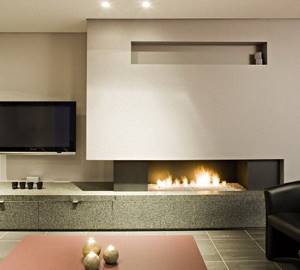
Benefits of using a gas fireplace
1. Easy to install - to install a gas fireplace, you just need to follow certain instructions specified in the technical specifications of the fireplace.
2. Gas fireplaces have high heat transfer and, accordingly, high efficiency.
3. A gas fireplace is lightweight, so it does not burden the living space.
4. A gas burner perfectly imitates a flame, thanks to which the fireplace brings warmth and comfort to the interior.
5. The ability to adjust the power of a gas fireplace is another advantage of this device.
6. Gas fireplace elements are made from fireproof materials that are resistant to fire.
7. A large number of varieties of gas fireplaces allows you to choose a fireplace depending on the individual characteristics of the interior.
8. A gas fireplace does not require a lot of time to kindle and heat up; after lighting the fireplace, it is enough to wait a few minutes to receive heat.
9. A gas fireplace in an apartment does not require solid fuel such as coal or wood, and does not require storage space.
10. Gas fireplace - easy to use and maintain, no need to clean the firebox from ash.
11. To install a gas fireplace, a chimney is not required; it is enough to make an outlet through which the gas air will escape.
12. Gas fireplace is an excellent solution for apartment owners with central gas heating; installing a gas fireplace allows you not only to get a beautiful thing in your interior design, but also to purchase an excellent heating device.
13. If we compare a gas fireplace for a home with a wood fireplace, the first option is more environmentally friendly, as it does not emit a large amount of harmful substances into the air.
14. A gas fireplace can operate without outside intervention for a long time.

Gas fireplace - place in the interior
When using a gas fireplace with an open firebox, such a fireplace must not be located in a place where there is exposure to air currents. Since drafts affect the burner and gas combustion is disrupted.
Gas fireplaces are an excellent solution for both residential and public spaces.
Scope of use of gas fireplaces:
- apartments,
- private houses,
- dachas,
- restaurants,
- offices,
- hotels,
- hotels.
The best option for installing a gas fireplace is in rooms that have a centralized gas supply.
The variety of shapes of gas fireplaces, from ordinary rectangular to extraordinary pyramidal or round, allows you to choose a fireplace in accordance with the size of the room and the appropriate cost.
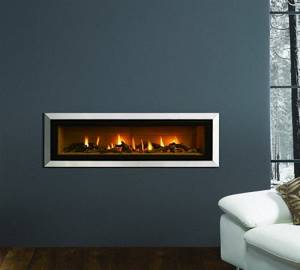
Types of gas fireplaces
Depending on the installation location, gas fireplaces are divided into:
- corner - installed directly in the corner of the room;
- built-in - installed in a wall niche;
- wall-mounted - attached to the wall;
- frontal - installed in the central part of the room.
In relation to transportation, gas fireplaces are distinguished:
- stationary type,
- portable gas fireplace.
Depending on the power, fireplaces are divided into:
- high power,
- medium-power,
- low power.
According to the type of fuel, gas fireplaces are distinguished, which operate on:
- propane-butane,
- natural gas.
Based on the appearance of the fuel hole, gas fireplaces are divided into:
- with an open firebox - with the ability to observe the flame, the efficiency of such a fireplace does not exceed 16%;
- with a closed firebox - such fireplaces have a special glass door that can sometimes be opened; if the door is closed, the efficiency is 70-80%.
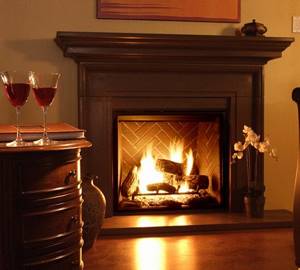
In relation to heat radiation, the following are distinguished:
- single-sided gas fireplace - a more common version of fireplaces, characterized by a high level of heat transfer;
- double-sided gas fireplaces are less popular, they are distinguished by their beautiful appearance and unusualness; such fireplaces need a lot of fresh air;
- gas fireplaces with three-sided radiation are characterized by unusual beauty, but have low heat output and are used to perform a decorative function.
Depending on the shape and functional features, gas fireplaces are divided into:
- gas stoves fireplaces,
- gas boilers, fireplaces,
- gas fireplaces convectors,
- gas infrared fireplaces.
Gas stoves and fireplaces serve to perform heating functions. Advantages:
- room decoration,
- heating reliability,
- high level of heat transfer.
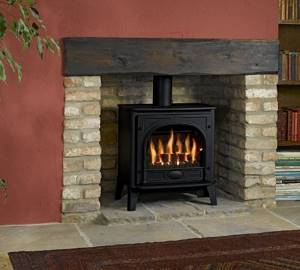
Fireplace stoves are made from cast iron or steel. The inner surface is laid out using heat-resistant bricks. Heat-resistant glass is used to make doors.
Fireplace stoves are characterized by 50% efficiency. The flame strength can be adjusted.
A gas boiler fireplace is a device that is responsible for heating the room, but at the same time is equipped with a portal and looks like a gas fireplace. A gas boiler fireplace makes it possible to regulate the temperature in the room.
A gas fireplace convector is a gas heater that looks like a fireplace. The front door of the convector is made of heat-resistant glass.
Advantages:
- beautiful appearance,
- silent operation,
- quick heating of the room,
- fire safety,
- a small amount of combustion products.
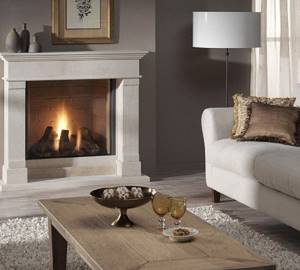
The gas infrared fireplace is one of the most popular gas fireplaces. The device operates on a butane-propane basis. They are used for heating both residential and industrial premises or outdoors. The room is heated by infrared waves and direct heating of the ceramic panel. The fireplace does not require large installation costs and quickly fills the room with warmth and comfort. An infrared gas fireplace does not require a chimney or ash removal. It is safe and has the ability to adjust the temperature. Infrared gas fireplaces should be installed away from flammable objects.
Recommendations for choosing a gas fireplace
1. For a house or apartment, it is better to choose a standard gas fireplace.
2. At the dacha, it is appropriate to install a gas fireplace stove, due to the possibility of quickly warming up the room.
3. The design of the fireplace should be in harmony with the overall interior of the room.
4. For a classic style, use a rectangular corner fireplace.
5. For a modern design style, it is better to choose a fireplace with an unusual shape and non-standard colors.
6. Fireplaces with two or three-sided radiation are not capable of heating a room, but are just a decorative element.
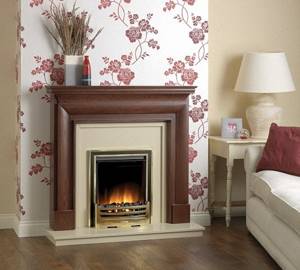
7. When choosing a fireplace, pay attention to the presence of a thermostat and built-in electrical appliances.
8. Be sure to compare the power of the room with the power of the fireplace, since a fireplace of medium or low power is not capable of heating a large room.
9. To buy a gas fireplace, contact specialized stores or construction supermarkets, where specialized specialists will help you choose a fireplace according to your individual needs.
10. When purchasing a gas fireplace and installation equipment, request certificates of compliance with all standards and a warranty from the manufacturer.
11. The price of a gas fireplace depends on the following factors:
- portal design,
- fireplace power,
- the material from which the burner is made,
- fireplace manufacturer,
- type of fireplace.
Installing a gas fireplace: requirements for pipes, equipment and chimney
1. When laying a gas pipe, the pipe must not be hidden in the walls; the pipe must only pass along the surface.
2. Check that the pipes are connected correctly to avoid gas leakage.
3. The room in which the fireplace is planned to be installed must be well ventilated.
4. The firebox must not be placed in an open draft.
5. When using a fireplace with an open firebox, flammable objects should be located away from the fireplace.
6. To install a fireplace, you need to arrange a smoke duct.
7. For an island-type fireplace, a chimney is required.
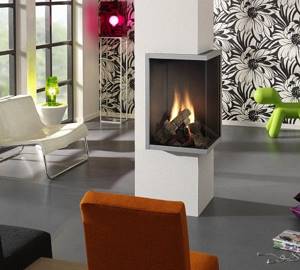
8. To ensure electrical thermoregulation and automatic switching on and off of the fireplace, electricity should be provided to the location of the fireplace.
9. During combustion of gas, water and carbon dioxide are released, so the chimney must be moisture resistant.
10. The best option for a chimney would be to install a stainless steel pipe, which is wrapped in heat-insulating, non-combustible material.
11. The following materials can be used to decorate the fireplace:
- a natural stone,
- fake diamond,
- brick,
- ceramic tile.
Firebox shapes
A gas fireplace is chosen not only for its performance; the shape of the firebox also has a significant impact. Moreover, it plays a role on what kind of heating equipment the fireplace uses, stationary or balloon method. There are several main types of fireboxes based on location:
- “Front” for placement against walls. (classic method).
- Corner types, for installation in corners.
- “Island types” are designed to be placed in the center of a room, around a specific location. (They have visibility from any side).
- Double sided. I use them for installation in two rooms at once, because the firebox is visible from both sides. As a rule, only minor class partitions are suitable for this purpose.

Front fireplace
When choosing, consider not only your aesthetic preference, but also the very possibility of connecting communications to the chosen location. For example, for suburban buildings, the supply can be made in any condition, even through a wall or ceiling. But apartment fireplaces are somewhat problematic; in such cases, the choice falls on only two main types of placement: corner and front. Moreover, they should be located near the external walls through which the pipe will be “installed”.

Advantages
- The advantages of biofireplaces are, first of all, their biofuel. It is based on pure ethyl alcohol processed into denatured alcohol.
- This substance burns no worse than ordinary alcohol, burning 1 liter of fuel in five hours, and during this time the same amount of carbon dioxide will be released as a person would exhale in the same period of time.
- There are also models of biofireplaces that provide pleasant aromas with which they fill the room.
- A biofuel fireplace does not need a hood because the combustion of fuel does not produce soot, gas, or smoke.
- The efficiency of this device is almost 100%, and the heat does not disappear from the room.
- Reliability of the material, simple installation and operation. Reliable flame insulation.
- Complex prevention is not needed.
- There will be no need for complex work associated with chimney installation.
- Installation of a biofuel fireplace does not require permission, etc.

Advantages
This type of heater has a whole range of advantages. Among the main advantages are the following:
- safety - the design of such devices is 100% sealed, which eliminates the possibility of dangerous gas entering the living space;
- absence of soot and soot during combustion - this factor eliminates the need for constant cleaning of chimneys and the internal surfaces of the fireplace itself;
- automatic operation - to start heating you do not need to light the fire yourself, because the combustion process begins after pressing one button; in addition, a special control panel allows you to regulate the intensity of the heat generated;
- compactness - the installation itself takes up less space, and there is no need to allocate space for storing firewood;
- versatility - such fireplaces are suitable for any home: for a summer house, for a country house and even for an apartment;
- different ways of “powering” heaters - such fireplaces can operate both from the main gas pipeline and from a cylinder;
- beautiful design – the devices are designed in such a way that they can easily complement any type of interior.
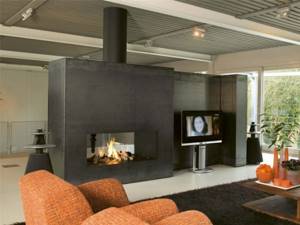
The nuances of installing equipment using bottled gas
When installing the unit, you need to know:
- When laying a gas pipe, it is placed on the surface of the wall.
- To prevent gas leakage, you should ensure that the pipes are connected correctly.
- The fireplace must be installed only in a ventilated area.
- The firebox must not be placed in a draft.
- When a fireplace has an open combustion chamber, flammable objects should not be placed close to it.
- A smoke duct is required for the unit to function.
- The best option for a chimney design is a stainless steel pipe, which is wrapped in non-combustible thermal insulation.
- To finish the unit, use natural or artificial stone, bricks or ceramic tiles.
Gas fireplace installation
A gas fireplace using bottled gas or any other consists of special compartments. For example, the firebox is considered the main and main element; it can be of completely different configurations and shapes. Open, closed, combined mode and others. In this way, a wide variety of design ideas can be created. The body is often made of durable heat-resistant steel; a burner and a reflector are placed inside - also known as a screen. All structural parts are covered with special panels that seem to imitate natural wood. The panels are made from heat-resistant materials such as ceramics. They prefer to make the front side where the door is made of glass so that they can enjoy the flame.
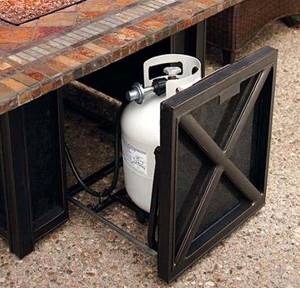
Installation of liquefied gas cylinder
The process of removing gases occurs using a chimney, which, by the way, also plays the role of fresh air ventilation
Take into account an important point when constructing channels, pay attention to the formation of draft, especially in closed chambers
As for the decor and cladding, great importance is attached to these details. When forming a “portal”, you need to use only durable materials, for example, the recently popular heat-resistant plasterboard, porcelain stoneware, and natural stone. The “portal” must provide an exit from the furnace from the heated air. By the way, automation is no stranger to fireplaces; as a rule, such systems are sold as a set and allow you to remotely and automatically regulate the temperature.
Device structure
Different manufacturers provide numerous options for gas fireplaces to choose from. But if you understand their structure, you can identify single key nodes that perform strictly defined functions.

Suspended version of the fireplace system
- The gas combustion process occurs in the furnace. It is this that determines the type of fireplace and can be open or closed.
- The smoke collector concentrates combustion products before they enter the chimney. Its purpose is to ensure that carbon monoxide evaporates without loss and does not remain in the room.
- Do not forget that the main purpose of such a fireplace is heating, so the heat exchanger is a mandatory part. With its help, heat is released from the increased area.
- The gas supply to the direct place of its combustion is provided by a gas burner.
- Dummy firewood.
- Flame control system.
With this configuration, it is not difficult to imagine the operating principle of the fireplace. After switching on, which is done from the control panel, gas supply begins. At the same time, automatic ignition occurs, which works thanks to the piezoelectric effect. Temperature sensors send a signal to the controller and “monitor” the air condition in the room. When a certain temperature is reached, the gas supply decreases and the flame intensity drops.
A gas fireplace without a chimney, despite its obvious advantages, involves additional work. In its natural form, it can only be used outdoors, for example, in the country. Working indoors, he still needs to remove combustion products.

Relaxation area in the apartment space
The fireplace deserves its name due to the fact that there is no need to install a chimney or maintain its height to ensure the required draft. The burnt gases are discharged through a special pipe through the wall to the street. It is also possible to equip an apartment with such a fireplace, but this requires permission from the management company.
Good to know: How to choose a gas fireplace using bottled gas, what quality criteria to focus on
Advantages of gas fireplaces
A gas fireplace has many advantages over wood-burning and electric models. Not everyone can tinker with firewood - they need to be chopped, dried, and organized for storage. In a city apartment, the masonry will take up an insane amount of space. And the burnt remains of firewood need to be disposed of. Plus you will need a serious chimney. Advantages - a slight smell of smoke, the cozy clicking sound of burning wood, the appearance of a natural flame.
Electric fireplaces are not fireplaces at all - they are the most common imitation. It is implemented using LCD displays with looped video playback. There are also options where the liquid evaporates and boils, illuminated by lamps. The effect of a living flame is also realized with the help of special lamps, creating a rather impressive picture. Pros - no chimney needed, no need to bother with coals. Minus - imitation is just that, imitation, without any comments.
A gas fireplace using bottled gas will be an excellent alternative to imitation and wood-burning fireplaces. Let's consider its advantages:
- Easy to install - just install it in the right place and connect it to the chimney.
- There is no need to store firewood - a significant space saver in an apartment or country house.
- Instant ignition without any fuss - enjoy a live flame immediately after switching on.
- A living flame is not an imitation, although you can’t hear the clicking of wood.
- No need to bother with cleaning up ash, coals and unburnt logs.
There are also some disadvantages:
- Gas equipment in itself is not very safe.
- Gas fireplaces require regular maintenance.
- The need to organize a chimney - in an apartment this can be a problem.
However, gas fireplaces are a compromise between electric imitation and classic wood-burning models.
The problem with organizing the removal of combustion products is solved by installing coaxial chimneys for fireplaces with closed fireboxes.
Is it profitable or unprofitable to heat a dacha with bottled gas?
An approximate estimate of the cost of heating with bottled gas can be determined from the following calculations:
- The calorific value of a cubic meter of firewood with 12% humidity is on average 2300-2500 kW/h, while for propane this characteristic is 6710 kW/h;
- The efficiency of a gas fireplace is 97%, the wood-burning version provides no more than 25-27%;
- The cost of a cubic meter of firewood is 1,600 rubles; for propane, the price of a cubic meter will be 19 thousand rubles.
As a result of the most approximate comparison, it turns out that to obtain an equivalent amount of heat from wood and propane, you will need 1.2 and 1.1 rubles, respectively. It turns out that heating using bottled gas will cost at least no more than wood in terms of fuel costs. If you take into account the transportation tariff and losses when cutting wood, then bottled gas may turn out to be more profitable.
Gas fireplace: requirements for installation at home
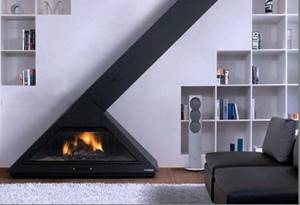
A gas fireplace is a possible source of a fire hazard, therefore, when installing and servicing it, owners must comply with fire safety rules and the operation of gas equipment. To connect such a device in a residential area of a house or apartment, the owner must obtain special permission from the gas service. It’s best to take care of this issue in advance by filling out all the necessary paperwork before purchasing and installing the heater. In addition, it will be necessary to take into account the fact that all work on gas networks, as well as the connection of such equipment to main and gas cylinder installations, can only be carried out by Gorgaz employees.
Fireplace location rules
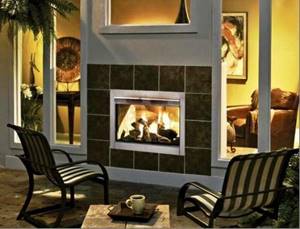
Installation of such heaters in residential premises is carried out in accordance with SNIP standards, fire and sanitary safety rules.
List of basic installation requirements:
- Requirements for the design of gas-fired fireplaces. This equipment must be certified for compliance with GOST. When selling fireplace equipment, in addition to the quality certificate, there must be instructions with equipment installation diagrams, tolerances and operating conditions for the nozzle.
- When connecting the device to the main gas, the internal gas pipeline will need to be routed from the kitchen to the room where the heater will be installed. Hidden wiring of such pipes is prohibited. In order to hide the pipes from external view, only removable protective screens can be installed.
- Requirements for wiring and power supply. The device requires connections to the home electrical network in order to ensure the operation of the automatic unit. In this case, the connection point should be located next to the heat source operating area.
- Requirements for the installation site. The room should have good natural ventilation, and the fireplace should not be placed in a draft. It is better if forced ventilation is provided in this room. For a device equipped with an open combustion chamber, it is necessary to arrange a pre-furnace area where flammable objects should not be located.
- Requirements for the smoke ventilation system. A gas fireplace for a home is placed in such a way that it can be connected to a chimney. The chimney in such heating systems is most often directed in a horizontal position to the street through the wall. As a rule, a pipe made of non-corrosive steel with fire-resistant thermal insulation is used as a gas duct.
- Requirements for fireplace lining. There are no serious requirements for the type of facing material; the main thing is that it must be heat-resistant, fire-resistant, and not heavy. Tiles made of natural or artificial stone and building ceramics are suitable for finishing the fireplace structure.
Homemade gas fireplace
Any home craftsman with experience and professional tools can assemble such a device. A gas burner is considered the basis of a fireplace; it is better to buy it together with a set of gas equipment and a safety unit in a retail chain, so that there are no problems with obtaining an operating permit from Gorgaz.
Step-by-step instructions for installing a heating fireplace with your own hands:
- Prepare the site for installation. Pre-check the weight load on the floor or ceiling. The total weight load of the fireplace should not exceed 800 kg per 1 m2 in one-story houses, and for multi-story houses - no more than 500 kg.
- The foundation is prepared, leveled and finished with fire-resistant building materials.
- Install thermal protection on the walls for installing wall-mounted or corner models.
- Installation of the combustion device and gas equipment, with subsequent connection to the main gas pipeline, is carried out exclusively by Gorgaz employees.
- Connect the fireplace to the chimney and check for draft. When a match is brought to the firebox, the fire should be diverted into the combustion chamber. In cases where the draft is insufficient, the chimney must be expanded or a forced ventilation system must be installed in the device. Forced ventilation is required if the house has fireplaces without a chimney.
- Finish the outer surface of the fireplace.
- Connect the automatic safety and regulation unit.
- Perform a test run of the fireplace.
Installation Requirements
- Firstly, in order for you to install a gas fireplace in your own home, gas must be supplied to it.
- Secondly, you will need to obtain special permission from the gas services, which will subsequently have to move the pipes to another room. Indeed, in most houses gas is installed only in the kitchen area. And it is simply impossible to carry out any manipulations related to putting a gas device into operation on your own. The fireplace in this case is no exception.
- Thirdly, you may have difficulties due to the lack of a high-quality chimney in the room. A gas appliance cannot function without it. But it can be done in the ventilation duct in the kitchen, which ideally should be made of stainless steel. Fortunately, the apartment, due to its layout, allows the installation of such chimneys.
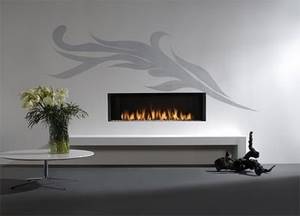
To install a fireplace, you need to take into account the following data, such as the footage of the living space, the strength of the interfloor ceilings, and the possibility of good ventilation. To simplify obtaining permits for the use of such a decorative element, you can connect it to an ordinary cylinder, which will have to be constantly refilled. In order to install a gas cylinder, you will need to allocate a special place in the room, so that it does not spoil the overall interior. Since a city apartment is not intended for such manipulations.
Advantages
You can choose a fireplace for your home that will be similar to any other traditional type of heating device. After all, it has a fairly convenient and compact combustion system. Also, such a device does not form soot and does not emit harmful substances when burning. It has an increased security system (there are sensors with a special ambient air analyzer). The burner maintains a constant gas pressure and monitors the continuity of fuel supply. This way the apartment remains safe.
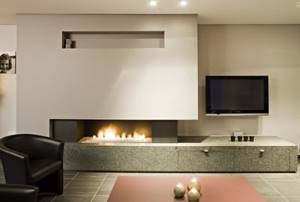
Thus, it becomes clear that it is quite possible to install a gas-powered fireplace, but to realize such a dream you will have to spend not only money, but also a lot of personal time. However, as a result, your apartment will be transformed beyond recognition, because a gas fireplace will give you the warmth of home comfort and the primitive element of fire.
- Operating principle of a heating elevator with an adjustable nozzle
- Panel heating: advantages and disadvantages
- How to lay a corner fireplace
- How to make a flexible chimney from stainless steel
Gas fireplaces from leading manufacturers
Despite the variety of fireplace designs and companies that manufacture them, only a few have conquered the calling. When it is difficult for a home owner to make a choice, it is necessary to turn to trusted companies whose products have been operating effectively for decades. Such companies that are represented on the Russian market include:
- Cheminees Philippe is a French company that produces a wide range of fireplaces with a variety of designs, prices and functionality.
- Gutbrod Keramik – German quality heating devices. The modifications are characterized by a comfortable design and high heat transfer.
- Element 4 - products of the Dutch company are characterized by a high level of automation and a modern design style.
- Waco&Co - heaters from a Belgian company. They are characterized by a unique design, expensive finishing materials and durability.
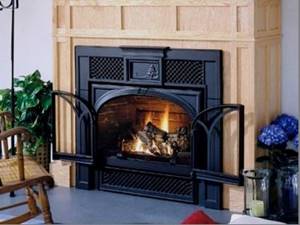
Gas firebox in classic Victorian style
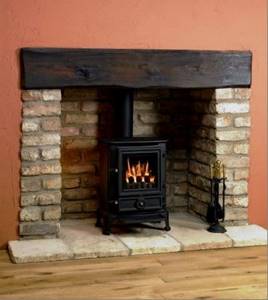
Gas stove-stove
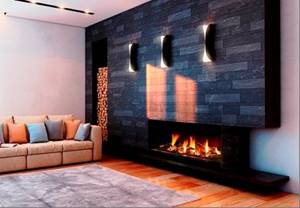
Gas fireplace built into the wall of the house
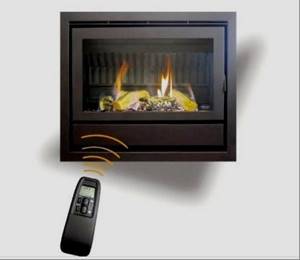
Remote control and synchronization with various devices
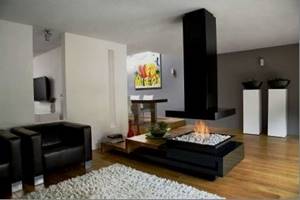
Luxury open fireplace
In conclusion, let us recall that gas fireplaces are quite multifunctional and high-tech modern heating systems. Which have an innovative control and protection system, as well as high decorative characteristics of the installation, capable of decorating not only a residential building, but also any apartment with a large area.
Manufacturers
When purchasing gas equipment, it is important to choose not only a functional, but also a reliable unit, and the buyer usually places the greatest trust in trusted companies. Below is a brief overview of them.
Cheminees Philippe, France
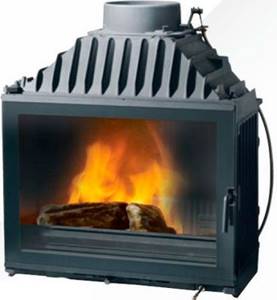
A popular French company, time-tested, producing a wide range of models of any functionality, design and price. The line of this manufacturer, Cheminees Diffusion, allows you to choose an inexpensive but reliable fireplace that can become a decoration and effectively heat any home or cottage.
Gutbrod Keramik, Germany
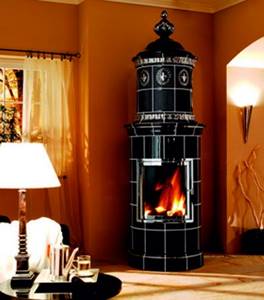
The peculiarity of this company is its specialization in gas stoves designed for heating rooms. The history of the development and production of stoves from this company goes back one and a half centuries; these models are time-tested and have increased heat transfer, pleasant design and high efficiency.
Waco&Co, Belgium
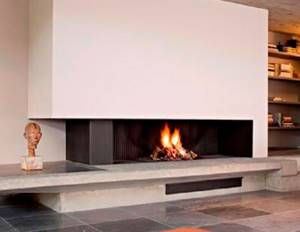
The company, specializing in the production of wood-burning and gas fireplaces, including exclusive ones, is able to satisfy the most demanding needs. The company relies on original design, finishing with expensive materials, while at the same time their products are reliable and functional.
Element4, Netherlands

Gas fireplaces from this manufacturer are distinguished by their laconicism and modern design, the emphasis is on the beauty of a live fire, and simple finishing and a high level of automation make it possible to reduce firebox maintenance to a minimum. Thanks to a minimum of expensive finishing, heating devices from this manufacturer are affordable.
Primary requirements
What are the basic rules for using gas fireplaces?
- Requirements for the gas pipeline. Gasification of houses and apartments involves entering the main line into the premises and wiring, according to the gas equipment installation project. To place a fireplace, you will have to supply gas, therefore, change the design of the gas pipeline. Installation of a new piece of equipment entails the creation and approval of a new project, and pipe installation can only be carried out by gas service workers.
- Rules for installing a fireplace. To assemble a gas fireplace with your own hands, you will have to carefully study the regulatory documents, which spell out all the rules for orienting the device in the room, the distance to pieces of furniture and other objects. Moreover, these indicators depend on the specific type and model of the gas burner. At the end of the installation, before starting the gas, you will still have to invite inspection representatives to agree on the correctness of the work performed. Any comment on their part will mean complete elimination of the discrepancy. These procedures can waste time and money.
- Certificate of conformity. Making a firebox on your own is imaginable. This will be a metal casing that will expand towards the door for better heat transfer. The dimensions of the firebox can be taken from the finished installation. There are even step-by-step instructions for laying the brick body of a future fireplace. But the gas burner and automated control system must be purchased at the store. There is no way you can do it yourself. In addition, the seller is required to provide a special certificate indicating that the equipment sold meets all requirements. A similar situation arises when installing a gas fireplace that consumes a propane-butane mixture from a cylinder.
Original island system
Related Posts
- How to install a stove in the house?
- Heating for home
- Brick fireplace
- Do-it-yourself stove-fireplace
- Fireproof heat-resistant glass robax and ceran from the German manufacturer schott
- Corner fireplace in the interior +70 photos
- How to make a fireplace from plasterboard with your own hands
- Electric fireplace installation
- Optimal fireplace sizes: what you need to know when making calculations
- Tiles for the stove: types and their features
- Decorative decoration of the fireplace
- Which door to choose for a stove or fireplace?
- Fireplace stove with water heating circuit: selection and self-installation
- Homemade Russian stove on the street under a canopy
- Why chimneys become contaminated with soot and how to get rid of it yourself
- 9 types of heat-resistant tiles for fireplaces and stoves: choosing the best
- Wood-burning stoves and their variety of designs
- Fire-battery 7b (thermophor)
- And let all the fuel burn out to the end! cast iron grate
- Do-it-yourself fuel for a biofireplace
- Making an electric fireplace with your own hands
- Requirements for a boiler for a bath
- How to glue fiberglass correctly?
- How to weld a metal sauna stove
- Options for making shelves for the garage with your own hands
Read with this
- How to install a stove in the house?
- Heating for home
- Brick fireplace
- Do-it-yourself stove-fireplace
- Fireproof heat-resistant glass robax and ceran from the German manufacturer schott
- Corner fireplace in the interior +70 photos
- How to make a fireplace from plasterboard with your own hands
- Electric fireplace installation
- Optimal fireplace sizes: what you need to know when making calculations
- Tiles for the stove: types and their features
